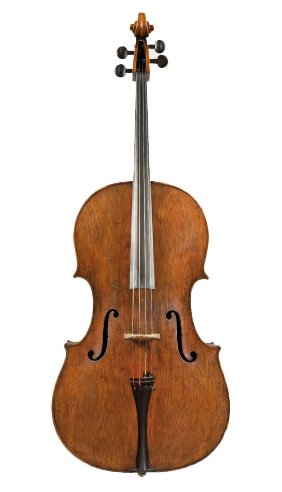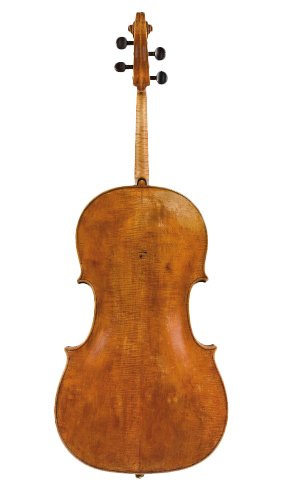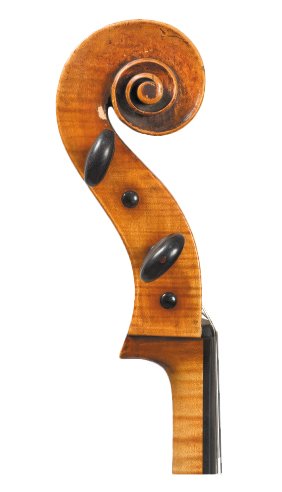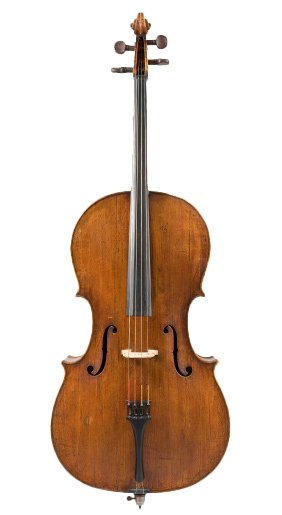The Roman school of violin making is one of the most overlooked of the classical Italian period. Like surprisingly many centres outside Cremona, it had its origins in the German states and its founding father and most distinguished practioner David Tecchler was in fact born in Augsburg in Bavaria in around 1666.
Tecchler did not begin his career in Rome until late in the sixteenth century, so it must be assumed that his apprenticeship took place in his native city and he arrived in Italy already a fully-fledged luthier. The most prominent workshop in the Augsburg at that time would have been that of the Edlinger family. Lute and viol makers were well established throughout the area by the mid seventeenth century, many traceable back to the town of Fussen, just over one hundred kilometres south of Augsburg. The Edlingers made lutes, but also significant numbers of violins in a distinctly early Germanic model at a time when Jacob Stainer was bringing a new level of refinement to this kind of work. While there may not be any documentary evidence linking Edlinger and Tecchler, the circumstances provide a good fit. Edlinger's violins and violas bear a strong resemblance to the characteristic Tecchler model, with rather square bouts, prominent out-turned corners, full arching and deeply furrowed edge, and large upright Fs. Even the scrolls are similar, with an extended last turn around a very prominent eye.



The end of the seventeenth century saw the climax of the Nine Year's War, fought between an alliance of European states against French expansionism. What effect this had on the personal and professional lives of violin makers is hard to judge. In 1688 there was fierce fighting in the Palatinate when the French army entered the state, but at some distance from Augsburg itself. Just possibly this may have been the impulse for Tecchler to make his way to Rome, and at about the same time Thomas Edlinger (III) moved to Prague, where he died in 1729.
Whatever the circumstances, Tecchler was working in Rome in the 1690s, the only significant violin maker there as far as is known at that time, but established amongst a whole community of lute makers with German names and very similar background to his own. Oddly, there had earlier been a very direct link to Cremona in Leopoldo Tedesco, who was one of the workmen listed as assistants in Nicolo Amati's workshop from 1652-54. Tedesco, from his name another German (literally, his name means Leopold the German) was unfortunately by no means a good reflection of Amati's strengths as teacher, and his career in Rome was short and undistinguished, and probably over by the time Tecchler arrived in the city. Tecchler himself seems to have met with success very quickly, and soon found an original cello model which he produced in fairly large numbers. It is for this that he is most celebrated today. The Tecchler cello is a large beast in its original form (many have been truncated in various ingenious ways to accommodate modern styles of performance), and there is a whole area of academic musicological debate given over to historical variations in size of the cello.
In Northern Italy the preferred model was big, over 30" generally, whilst in other areas it was a smaller instrument overall, with a back length around 28". This changed quite quickly around 1700 when the Cremonese established a median form of 29½" length which has remained the standard ever since. Tecchler was a little tardy in coming around to the smaller form, although examples do exist made by him. Quite why there was such variation is not entirely clear, but the manufacture of strings must have certainly been an element. Providing a resonant C string and a balanced A makes considerable demands on the string, and the length and tension have to be carefully regulated on the instrument. Another factor is local pitch, which varied tremendously from country to country and from city to city thoughout Europe. The pitch in Rome was low, thought to have been around A=390, requiring a longer diapason; there is evidence that pitch varied with latitude, increasing in semitone steps with each northward journey within Italy. Even Tecchler's violins- and indeed those of his contemporary in Naples, Alessandro Gagliano- have a longer string stop than is normal, reinforcing the idea that they were made to play at a significantly lower pitch than Cremonese instruments. Rome was also the European centre of string making, and had been for some time. Roman Lute and Viol strings were exported and known everywhere, and if anyone would have been able to take advantage of the best and latest developments in string-making, and indeed to have driven the process, it would have been local makers like Tecchler and his followers. Instrument makers were themselves responding to musicians of course, and in Rome at this time Arcangelo Corelli had established himself as one of the first great internationally known virtuosos and teachers, providing Tecchler with a ready demand for instruments. His Concerto Grossi are among the first great compositions incorporating the cello rather than the bass viol or violone.



As it is, the typical Tecchler instrument has a high full arch, a long stop length and a very impressive character. This form became less sustainable for the violin in more recent times, when the powerful low arched Strad became dominant, but for the cello, the large air volume offered by high archings remains an advantage in helping to provide a manageable and responsive bass, and the deeply channelled edges that are associated with Stainer and perpetuated by Tecchler are less problematic. For the violin, this arch is rather limiting, and provides a light tone that cannot compete with the power and profundity of a great del Gesu.
Tecchler's workmanship was very fine, and he used particular materials- often a two piece slab-sawn back with an intense pattern of small flames, combined with a broad-grained front. Sadly, the tendency for shrinkage cracks to appear in slab-cut wood does exhibit itself in his work, and there is often a degree of distortion in the arches that indicates that the wood was not perfectly dried when Tecchler began to work it. He used a fine and particularly delicate orange-toned varnish, and the ground is often quite dark. As with most makers outside Cremona, he preferred beech wood for his rather broad but well inlaid purfling. Within the instrument, the blocks and linings are generally of pine or spruce, with the centre bout linings morticed into the large corner blocks, although the mortice is generally cut away and exposed by the trimming of the block itself. It is difficult to assign a particular working method to Tecchler- the outlines are consistent, well regulated and symmetrical, and the morticed linings may indicate the use of a mould. He also made use of locating pins set well inside the purfling at each end of the plate. The ribs however are brought together in a long taper extending right to the ends of the corners, in what we usually refer to as the German manner rather than the subtle overlapping joint used by other Italian makers. Cellos frequently show the position of a large peg in the centre of the back that was once used as a location for a carrying strap.
Tecchler's scrolls are very distinctive, very cleanly cut, symmetrical and regular, but with a Staineresque last turn of the volute extending around a large central eye. The whole head is nevertheless quite slender. Generally, the soundholes are very Germanic, set upright and with an open cut and large, curving nicks. But a certain early type exists which has a very Milanese slant, and a broader Stradivarian type of wing. Whether Tecchler stopped off there on his way towards Rome is perhaps a speculation too far.
As with the Venetians- coincidentally another renowned centre of string making in this period, Roman makers concentrated on the cello and the violin. Tecchler famously inscribed on the label of one of his violas that it was the third one he had made, and this was in 1730, late in his career. By this time he had regular assistance in the workshop, and by the time of his death in 1747, David Tecchler had been responsible for training or at the very least guiding the leading makers of the Roman school, Michael Platner, Francesco Emiliani, and Giulio Cesare Gigli.